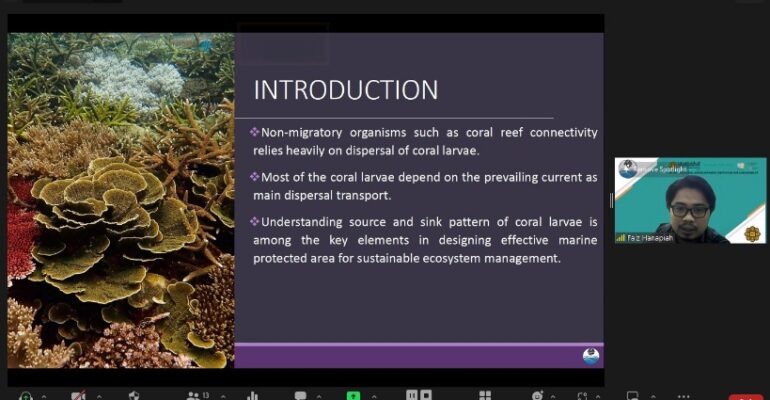Scores IPB University Revealed Numerical Modeling to Detect the Distribution Pattern of Coral Reef Larvae

Department of Marine Science and Technology (ITK) IPB University returned to present the best experts in the School of Coral Reef Restoration (Scores). This time, Dr Muhammad Faiz Mohd Hanapiah from International Islamic University Malaysia (IIUM) was the guest speaker with the theme 'Connecting the Dots: Dispersal of Coral Larvae in Pahang Coastal Waters'.
Dr Faiz said that the distribution of coral reefs in the high seas is related to the conditions of these waters. One of them is oceanographic conditions or ocean currents that act as agents that carry planula larvae until they find a suitable substrate.
"Modeling the distribution of coral reef larvae needs to be studied to provide information on the potential for coral reef recovery and the sustainability of coral biota offspring. This aims to see the success of a coral reef ecosystem in recovering coral habitats due to natural or anthropogenic damage," he said.
He said that non-migratory organisms such as coral reefs are very dependent on the distribution of their larvae. This larvae distribution depends on the current as the main carrier in spreading until it reaches the right substrate for larval breeding.
"Understanding the sources and sinking patterns of coral reef larvae is key in designing marine protected areas for sustainable ecosystem management," said the Malaysian coral researcher.
Dr Faiz explained that there are several methods used to estimate the larvae distribution pattern, including population genetic, direct tracking and most recently numerical modeling. Numerical modeling is one method that is widely used in determining current patterns in the sea.
"The main components in modeling larval distribution are the calibration of the water hydrodynamics model, potential sources of larval presence, larval dispersal time after spawning, and the duration of pelagic larvae," he said.
The calibration process, he said, requires data such as the slope of the seabed surface, bathymetry, and wind speed and direction that affect the current. The location that is the potential source of larvae is in coral reef waters near the coast.
Meanwhile, the larvae dispersal time itself is influenced by the surface temperature of the water. A gradual increase in temperature will accelerate spawning. "From March to May there is an increase in water temperature to 31 degrees Celsius and from April to May there is a spawning season," he explained.
Meanwhile, continued Dr Faiz, the duration of pelagic larvae is the time span in which the larvae swim freely until they settle on a suitable substrate and grow into adult corals. In species such as Acropora, the duration of pelagic larvae lasts around 10-14 days after spawning.
"The modeling that we did, for example in the Tioman Islands, found that the distribution of larvae reached a distance of up to 70-100 km from the spawning site and about 40-50 km from the coast," explained Dr Faiz.
"Innovation is needed to support various coral reef research by academics and share data from several government agencies and conduct workshops and training with the community," concluded Dr Faiz.
One of the coral researchers from IPB University expressed his impression of participating in this activity. "I am very excited and curious to hear more about Dr. Faiz's research in Malaysia. Until now, Scores has presented many speakers ranging from national and international. Hopefully we can learn together and gain new knowledge in this forum," she said. (DHAA/ARS/Rz) (IAAS/RUM)



